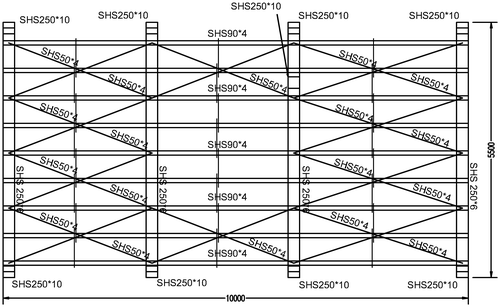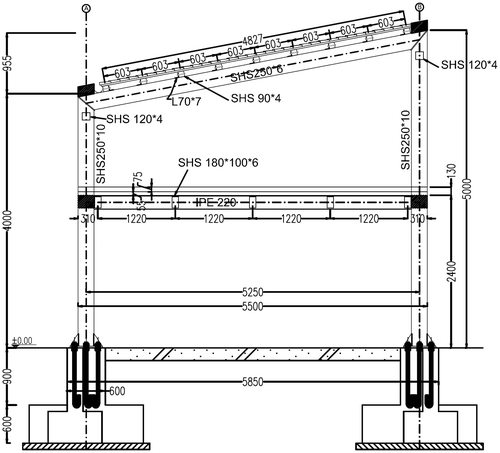Abstract
Due to the increased urgency with which environmental issues are currently being prioritized, business sectors such as construction, that have been identified as one of the largest consumers of raw materials and energy, are actively involved in research aiming to optimize construction processes and products in terms of environmental impact. Although researchers have pointed out various issues and aspects of a construction project’s delivery process that can significantly affect its environmental impact, the extent to which these issues can influence the total environmental impact of the project is unclear. The current research aims to investigate and eventually quantify the influence of a number of such parameters, utilizing an existing steel-framed building as the basis for the necessary calculations. The conclusions drawn illustrate the actual extent of the influence of the examined life cycle parameters, while also offering specific insight in regard to the determination of criteria that can be used as the basis for recommendations for similar projects.
1. Introduction
Out of the three dimensions of sustainability – economic, social and environmental – it is the environmental issues that are, for some time now, being prioritized as more urgent in regard to the immediate future of mankind (European Environment Agency Citation2007). Terms such as “reduced carbon footprint” and “green” products or services have been placed high on the business agenda and are consequently often used to advertise the achievements of product manufacturers and service providers that have managed to respond to the sustainability challenge and adjust their businesses to the new requirements (Bhander, Hauschild, and McAloone Citation2003).
After having been identified as one of the largest consumers of raw materials and energy, the construction sector is actively involved in establishing practices that promote sustainability in regard to both construction materials and processes (Bragança, Mateus, and Koukkari Citation2007; Intini and Kühtz Citation2011; Karimpour et al. Citation2014; Kim et al. Citation2014; König and De Cristofaro Citation2012). Construction product manufacturers are engaged in research aimed at lowering their products’ environmental impact in order to gain a competitive advantage in today’s sustainability-oriented market (Haapio Citation2010; Melià et al. Citation2014) and construction companies are on a similar track, analysing and assessing the environmental impact of construction processes required for the delivery of technical projects in order to identify the areas where improvements can be made (Love, Edwards, and Smith Citation2013; Ochoa Citation2014; Passer et al. Citation2015; Sarkisian Citation2014).
In sectors such as steel construction, where the sustainability potential of the main materials used is increased to begin with (Burgan and Sansom Citation2006), the optimization of construction processes becomes a crucial issue in relation to achieving sustainability (Chubbs and Steiner Citation1998). Researchers have pointed out various issues and aspects of a construction project’s delivery process that can significantly affect its environmental impact (Grant and Ries Citation2013; Hoxha et al. Citation2014). Basbagill et al. (Citation2013) highlighted that construction materials can noticeably influence the total environmental impact of a building, while Blengini (Citation2009) showed that compared to the environmental burdens associated with the materials embodied in the building shell of a residential building, the recycling potential is 29 and 18% in terms of life cycle energy and greenhouse emissions, respectively. The influence of assumptions in end-of-life modelling was described by Sandin, Peters, and Svanström (Citation2014), while research is also ongoing in regard to the end of life of buildings (Martínez, Nuñez, and Sobaberas Citation2013; Silvestre, de Brito, and Pinheiro Citation2014).
The extent, however, to which these issues can influence the total environmental impact of a construction project is often unclear. The current research aims to investigate the influence of a number of such parameters, which are related to the delivery of steel buildings, on the environmental impact caused by the life cycle of the whole project. This is a relatively new approach that has not been so far adequately covered in the existing literature, as researchers often focus on a specific aspect of a construction project’s life cycle. The inclusion of several life cycle parameters allows for the formation of a much wider perspective in regard to the quantification of their influence on the total environmental impact of a building project, while it should also be noted that the results of the current research are presented in a variety of widely used environmental impact indicators. It should be noted that within the current analyses, the term “total environmental impact” refers to the environmental impact associated with the life cycle of the steel building, which included the stages, materials and processes as described in the following sections.
A steel-framed residential building is used as the basis for the calculations and the influence of the examined parameters is quantified and assessed through the results obtained. The selection of the life cycle parameters to be examined covers a variety of significant issues in terms of the environmental impact caused by steel structures and particularly buildings, while each parameter is examined individually – with all the others kept constant – in order to isolate its effects and actual influence.
2. Methodology
The delivery of any construction project includes a series of construction processes that are performed and certain amounts of construction materials that are used. In order to include as many of these processes and materials as possible – and thus create an accurate environmental account of the project’s delivery – the concept of the life cycle is used (Frangopol and Soliman Citation2016). The life cycle of construction projects consists of four main stages, namely: raw material acquisition, construction, use/maintenance and waste treatment. For the current analyses, the life span of the steel building is considered to correspond to a time period of 50 years and no maintenance or repair processes have been taken into account for this period.
The methodology which allows the quantification of the environmental impact caused by the life cycle of a project and is used for the purposes of the current research is life cycle assessment (LCA) (ISO Citation2006a, 2006b; Frischknecht et al. Citation2015; Saur Citation2003).
The existing steel-framed building which is selected as the basis for the calculations required is a single-storey 10 × 5.5-m plan view building (Figures and ) with a steel deck, constructed in Thessaloniki, Greece. The load-bearing frame of the building is constructed of SHS (square hollow sections) structural steel sections and the current analyses refer to the whole building, including its foundation and ground floor. The main construction materials and processes that are used for the building and taken into account for the current analyses are briefly described in Table . In regard to the construction stage of the building’s life cycle, the excavation required for its completion was taken into account.
Table 1. Construction materials and processes required for the construction of the steel building.
The aspects of the building’s life cycle that are examined are presented in Table and include the steel construction materials used, material transport and waste treatment scenarios. This approach is quite new compared to the majority of relevant research, which mainly focuses on individual life cycle parameters rather than a group of them. It therefore leads to useful conclusions that could not have been drawn without the more collective methodology adopted by the current research.
Table 2. Aspects of the steel building’s life cycle that are examined.
In regard to the impact assessment, a set of widely recognizable impact indicators is utilized, as used in the majority of similar research analyses and documentation such as the European EN standards referring to the sustainability of construction works (CEN Citation2012a, 2012b). In specific, the environmental impact assessment indicator used for the current LCA analyses is Global Warming Potential (GWP), as included in the CML 2 baseline 2000 (V2.05 / World, 1995) methodology, which contains a number of widely recognizable and used impact indicators. The GWP indicator used contains the climate change factors of the Intergovernmental Panel on Climate Change (IPCC Citation2007) with a time frame of 100 years, while the environmental impact results are calculated in kg of carbon dioxide equivalent (kg CO2 eq.). The GWP has been defined by the Intergovernmental Panel on Climate Change (IPCC Citation2001) as the ratio of the time-integrated radiative forcing from the instantaneous release of 1 kg of a trace substance relative to that of 1 kg of a reference gas:
where TH is the time horizon over which the calculation is considered, ax is the radiative efficiency due to a unit increase in atmospheric abundance of the substance in question (i.e. Wm−2 kg−1), [x(t)] is the time-dependent decay in abundance of the instantaneous release of the substance and the corresponding quantities for the reference gas are in the denominator.
The functional unit for the LCA is the construction of the steel-framed residence, while the geographic coverage refers to the Greek and European regions. The environmental data used are mainly drawn from existing LCI (life cycle inventory) databases (Takano et al. Citation2014) such as the LCI database developed at the Aristotle University of Thessaloniki (Zygomalas et al. Citation2012) and the Ecoinvent LCI database. It should be noted that all the environmental impact data referring to steel materials have been taken specifically from the Aristotle University of Thessaloniki database and do not include any environmental benefits from recycling of the steel of any other end-of-life processes or treatments.
3. Environmental impact assessment
3.1. Construction materials
The acquisition of the structural steel materials used for the construction of the examined building can either be manufactured locally in Greece (local steel products) or processed into final products from semi-finished steel products which have been imported from foreign suppliers (semi-imported steel products). Each acquisition route has its characteristics, and the purpose of the current analysis is to determine their effect on the building’s life cycle environmental impact. Two scenarios are defined – one for each acquisition route – and the respective environmental impacts are calculated. The environmental impact data that are used are drawn from the Aristotle University database and they are based on annual statistic data regarding the inland production of structural steel and the import of semi-finished steel products (Zygomalas and Baniotopoulos Citation2011). It is noted that these data-sets include the processes required for the transport of the semi-finished materials from all countries of their origin.
The distance for the transport of the construction materials from the suppliers to the site is assumed to be 20 km, while the distance for their transport to the various waste treatment facilities (recycling plants, landfills, etc.) is assumed to be 50 km. In regard to the waste treatment of the retrieved construction materials at the end of the building’s life cycle, it is assumed that 90% of the steel products is retrieved and sent for recycling, while the remaining 10% is considered irretrievable and is therefore disposed of in landfills. For the concrete, it is assumed that 80% is retrieved and sent for recycling (crushed to be used as gravel), while the remaining 20% is considered irretrievable and disposed of in landfills.
Based on these assumptions, the environmental impact of the building’s life cycle is calculated. The results are presented in Figure for the construction of the building with each of the two acquisition routes (local and semi-imported steel products) and the recycling end scenario, which is the same for the two acquisition scenarios. As can be observed, the construction of the steel building with locally manufactured steel products causes a smaller environmental impact (38,435 kg CO2 eq.) in comparison to the semi-imported steel product construction scenario (44,039 kg CO2 eq.). The recycling scenario provides significant environmental benefits (−13,012 kg CO2 eq., the negative value referring to benefit rather than burden). These impact results are also calculated for the remaining environmental indicators used by the CML 2 baseline 2000 methodology and are presented in Table .
Table 3. Steel materials’ acquisition impact results for the CML 2 baseline 2000 indicators.
Furthermore, the total environmental impact of the building’s life cycle (the result of adding the impact of the construction and the benefit of recycling) with the local steel products is calculated at 25,423 kg CO2 eq., while for the semi-imported products the total life cycle impact is 31,026 kg CO2 eq. It is therefore evident that the acquisition route of the structural steel materials noticeably increases the total environmental impact of a steel building’s life cycle.
3.2. Materials’ transport distance to site
The construction materials required for the construction of the steel building have to be transported to the site from the various suppliers. These transport processes often cause noticeable environmental impact and should therefore be included in construction-related LCA analyses. The amount of environmental impact caused by transport processes depends on the weight of the materials transported and the distance that has to be covered. The means of transport is also important, but for the current analyses, it is assumed that all materials are transported by trucks. In order to examine the influence of the transport distance from the suppliers to the construction site, three scenarios are defined. For the first scenario, a 50-km distance is assumed, referring to suppliers that are in close proximity to the site. For the second scenario, the same distance is assumed at 100 km, referring to cases where the suppliers are further away from the site. Thirdly, a 300-km distance is examined, referring to suppliers that are quite far from the project’s site.
In regard to the remaining parameters, the distance for the transport of the retrieved materials to the various waste treatment facilities is assumed to be 50 km, while the steel materials are assumed to be manufactured locally. In regard to the waste treatments, it is assumed that 90% of steel products is recycled and the remaining 10% is disposed of in landfills, while 80% of the concrete is recycled and 20% is disposed of in landfills.
Based on these assumptions, the environmental impact of the building’s life cycle is calculated. The results are presented in Figure for the construction of the building with each of the three transport distances assumed (50, 100 and 300 km to the site) and the recycling end scenario, which is the same for the three distance scenarios. As can be observed, the construction of the steel building with the 50-km distance to the site causes a slightly smaller environmental impact (39,231 kg CO2 eq.) in comparison to the 100-km (40,557 kg CO2 eq.) and the 300-km scenarios (45,862 kg CO2 eq.). The recycling scenario again provides environmental benefits of −13,012 kg CO2 eq. (the negative value referring to benefit rather than burden). These impact results are also calculated for the remaining environmental indicators used by the CML 2 baseline 2000 methodology and are presented in Table .
Figure 3. Environmental impact of the building’s construction for each acquisition route and the recycling end scenario.
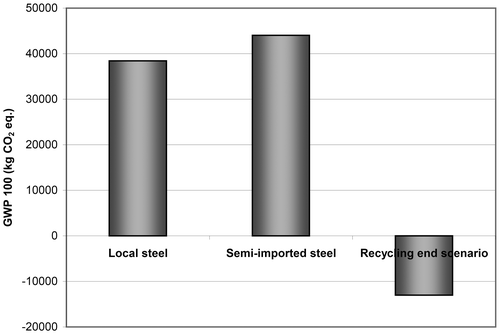
Table 4. Transport to site impact results for the CML 2 baseline 2000 indicators.
The total environmental impact of the building’s life cycle (the result of adding the impact of the construction and the benefit of recycling) is found at 26,218 kg CO2 eq. for the 50-km scenario, 27,544 kg CO2 eq. for the 100-km (a 5.1% increase) and 32,850 kg CO2 eq. for the 300-km scenarios (a 25.3% increase from the 50-km scenario). It is therefore evident that the transport distance of the construction materials from the suppliers to the site can have a visible effect on the total environmental impact of the building, which can increase further for proportionally increased transport distances.
3.3. Retrieved materials’ transport distance
At the end of a building’s service life and after the decision for demolition has been made, efforts are made to retrieve as much of the construction materials used. This is done in order for the retrieved materials to be sent for recycling or reuse and avoid disposing them in landfills, which causes further environmental impact. After the demolition has been completed, the retrieved materials have to be transported to various waste treatment facilities, such as sorting and recycling plants. These facilities are often found in quite larger distances from a building’s site compared to material suppliers, as they are less in number and operate only in specific locations. As a result, the processes required for the transport of the retrieved materials to these facilities often cause noticeable environmental impact and should therefore be included in construction-related LCA analyses.
As was the case with the transport of the materials to the construction site, the amount of environmental impact caused depends on the weight of the materials transported and the distance that has to be covered. It is again assumed that all materials are transported by trucks and in order to examine the influence of the transport distance to the waste treatment facilities, three scenarios are defined. For the first scenario, a 100-km distance is assumed, for the second, a 200-km distance and thirdly, a 500-km distance is examined. In regard to the remaining parameters, the distance for the transport of the construction materials to the site is assumed to be 20 km, while the steel materials are assumed to be manufactured locally. In regard to the waste treatments, it is again assumed that 90% of steel products is recycled and the remaining 10% is disposed of in landfills, while 80% of the concrete is recycled and 20% is disposed of in landfills.
The environmental impact results are presented in Figure for the building’s construction for the three transport distances to the waste treatment facilities scenarios (100, 200 and 500 km to the site) and the recycling end scenario, which is the same for the three scenarios. As can be observed, the construction of the steel building with the 100-km distance to the waste treatment facilities causes a slightly smaller environmental impact (39,761 kg CO2 eq.) in comparison to the 200-km (42,414 kg CO2 eq.) and the 500-km scenarios (50,371 kg CO2 eq.). The recycling scenario again provides environmental benefits of −13,012 kg CO2 eq. (the negative value referring to benefit rather than burden). These impact results are also calculated for the remaining environmental indicators used by the CML 2 baseline 2000 methodology and are presented in Table .
Figure 4. Environmental impact of the building’s construction for the three transport distances to the site scenarios and the recycling end scenario.
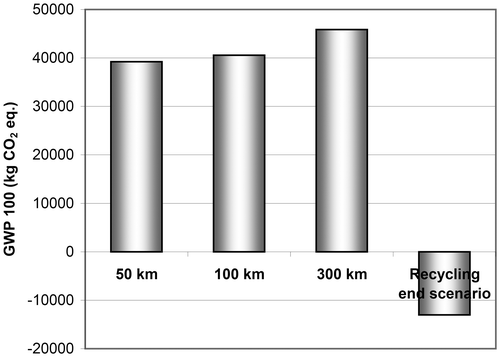
Table 5. Transport to waste treatment facilities: results for the CML 2 baseline 2000 indicators.
The total environmental impact of the building’s life cycle (the result of adding the impact of the construction and the benefit of recycling) is found at (26,749 kg CO2 eq.) for the 100-km scenario, (29,401 kg CO2 eq.) for the 200-km (a 10% increase) and (37,359 kg CO2 eq.) for the 500-km scenarios (a 40% increase from the 100-km scenario). It is therefore evident that the transport distance of the retrieved construction materials to the waste treatment facilities has a significant effect on the total environmental impact of the building, which, as expected, increases for proportionally increased transport distances.
3.4. End scenarios
The capacity of structural steel for recycling stems from its property to be melted and remoulded – with the proper substance additions – into new steel products that do not compromise the quality of the material. Its potential for reuse is another sustainable option, as structural steel members that are investigated and found not to carry significant wear can be used “as is” in other structures. This route avoids the need for the remanufacturing of the new quantity of steel as the final product is already available and as a result, the environmental impact of the material is greatly reduced.
For the current LCA analysis, three end scenarios are examined, each corresponding to a different way of handling the retrieved steel materials at the end of the building’s service life. The first scenario refers to the recycling of the retrieved construction materials, the second one to their reuse and the third to their disposal in landfills. The assumptions taken into account for each end scenario are presented in Table . In regard to the other life cycle parameters that are examined, the steel construction materials are assumed to be manufactured locally, while the distance for the transport of the construction materials from the suppliers to the site is assumed to be 20 km and the distance for their transport to the various waste treatment facilities (recycling plants, landfills, etc.) is assumed to be 50 km.
Table 6. End-of-life scenarios developed for the handling of the retrieved materials.
The environmental impact caused by the construction of the steel-framed building and the three alternative end scenarios is presented in Figure . As can be observed, the impact caused by the building’s construction is 38,435 kg CO2 eq., while the benefits provided by the recycling end scenario were calculated at −13,012 kg CO2 eq. (the negative value refers to environmental benefit). The beneficial influence of the recycling of the materials is evident since the latter reduces the impact of the building’s construction by more than a third. Further analysis of the recycling scenario impact shows that it is the steel elements that are responsible for the largest percentage of the benefits provided. The recycling of steel elements can therefore play a significant role in ensuring the sustainability of construction projects since it removes the need for the extraction of new quantities of raw materials by utilizing steel and iron scrap that would otherwise be disposed of.
Figure 5. Environmental impact of the building’s construction for the three transport distances to the waste treatment facilities scenarios and the recycling end scenario.
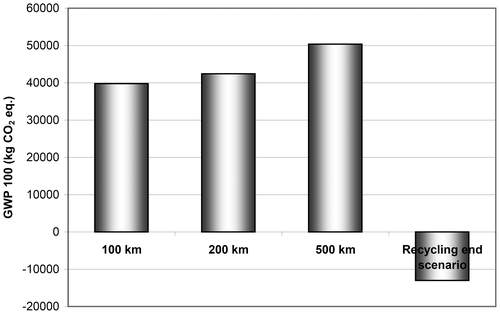
Figure 6. Environmental impact of the construction and alternative end scenarios for the steel building.
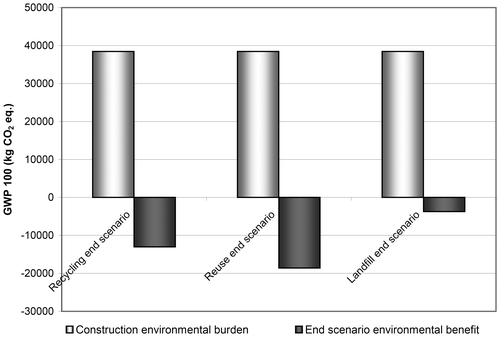
The benefits provided by the reuse end scenario were calculated at −18,582 kg CO2 eq. In this case, the beneficial influence of the reuse of the steel elements leads to remarkable environmental benefits that are almost half of the impact caused by the construction of the building. These benefits are attributed to the fact that reuse avoids the manufacturing processes required for recycling and is thus capable of providing even greater environmental benefits. These results show that reuse is the optimal end scenario – even in comparison to recycling. As far as a construction project’s design is concerned, it would therefore be preferable to include provisions that will enable the maximization of construction material reuse when the service life of the project has ended.
Thirdly, the benefits provided by the landfill scenario were calculated at only −3737 kg CO2 eq. These quite smaller benefits are attributed to the small quantities of materials recycled and the fact that the disposal of the remaining materials in landfills causes significant burden rather than benefits. It is therefore obvious that landfill disposal does not only cause additional environmental burden – which noticeably decreases any recycling benefits – but also prevents potential benefits that could be obtained by other material treatments such as recycling and reuse.
The results obtained by the analyses also refer to the impact of the steel building’s alternative life cycles on the remaining environmental indicators used by the CML 2 baseline 2000 methodology. These results are presented in Table , for the construction of the building and the three alternative end scenarios.
Table 7. Environmental impact results for the CML 2 baseline 2000 indicators.
4. Conclusions
The application of methodologies such as life cycle assessment (LCA) within construction has allowed the quantification of the environmental impact caused throughout the life cycle of technical projects such as buildings. The current research investigated the influence of several key aspects of a steel building project’s life cycle on the total environmental impact caused. A relatively new approach was implemented, focusing on not only one but several life cycle parameters, thus allowing for the formation of a much wider perspective in regard to the quantification of their influence on the total environmental impact of the building. An existing steel-framed building was used as the basis for the calculations and a series of LCA analyses were conducted. The findings can be used for the formation of guidelines regarding steel construction projects in terms of environmental impact optimization.
The first aspect of steel construction which was examined was the acquisition route of the structural steel products used. It was found that the construction of the building with locally manufactured structural steel causes a smaller environmental impact in comparison to products that have been processed from semi-finished steel products which have been imported from foreign suppliers. Further examination of the total environmental impact of the building’s life cycle (the result of adding the impact of the construction and the benefit of recycling) showed that the acquisition route of the structural steel materials noticeably increases the total environmental impact of a steel building’s life cycle.
The transport of the construction materials was also found to noticeably influence the total life cycle environmental impact. The transport distance of the construction materials from the suppliers to the site was found to have a visible effect, while the transport of the retrieved construction materials to the waste treatment facilities significantly influences the total environmental impact of the building. As expected, the influence of both transport processes increases noticeably for proportionally increased distances.
In regard to the end scenarios available for the handling of the retrieved materials at the end of a building’s life cycle, the recycling scenario was shown to have a very beneficial influence, reducing the environmental impact of the building’s construction by more than a third. The reuse scenario led to even more remarkable environmental benefits, almost half of the impact of the building’s construction. This was attributed to the fact that reuse avoids any manufacturing processes altogether and is thus capable of providing even greater environmental benefits than recycling. It is therefore suggested that reuse is the optimal end scenario; it should be considered at a construction project’s design stage so that provisions that will enable the maximization of construction material reuse when the service life of the project has ended can be taken into account. Finally, landfill disposal was shown to not only cause additional environmental burden but also prevent potential benefits that could be obtained by other material treatments such as recycling and reuse.
Based on the results and conclusions of the current research, it can be suggested that investigating the impact of additional life cycle parameters or including additional processes of the life cycle of the building can increase the scope and application of the findings.
Disclosure statement
No potential conflict of interest was reported by the authors.
Funding
This research has been co-financed by the European Union (European Social Fund – ESF) and Greek national funds through the Operational Program “Education and Lifelong Learning” of the National Strategic Reference Framework (NSRF) – Research Funding Program: ARCHIMEDES III. Investing in knowledge society through the European Social Fund.
References
- Basbagill, J., F. Flager, M. Lepech, and M. Fischer. 2013. “Application of Life-Cycle Assessment to Early Stage Building Design for Reduced Embodied Environmental Impacts.” Building and Environment 60: 81–92. doi:10.1016/j.buildenv.2012.11.009.
- Bhander, G. S., M. Hauschild, and T. McAloone. 2003. “Implementing Life Cycle Assessment in Product Development.” Environmental Progress 22 (4): 255–267. doi:10.1002/ep.670220414.
- Blengini, G. A. 2009. “Life Cycle of Buildings, Demolition and Recycling Potential: A Case Study in Turin, Italy.” Building and Environment 44 (2): 319–330. doi:10.1016/j.buildenv.2008.03.007.
- Bragança, L., R. Mateus, and H. Koukkari. 2007. “Perspectives of Building Sustainability Assessment.” In Portugal SB07 – Sustainable Construction, Materials and Practices, edited by L. Bragança, M. D. Pinheiro, S. Jalali, R. Mateus, R. Amoêda, and M. C. Guedes, 356–365. Amesterdam: IOS Press.
- Burgan, B. A., and M. R. Sansom. 2006. “Sustainable Steel Construction.” Journal of Constructional Steel Research 62: 1178–1183.10.1016/j.jcsr.2006.06.029
- CEN (European Committee for Standardization). 2012a. European Standard EN 15978: Sustainability of Construction Works – Assessment of Environmental Performance of Buildings – Calculation Method. Brussels: European Committee for Standardization (CEN).
- CEN (European Committee for Standardization). 2012b. European Standard EN 15804: Sustainability of Construction Works – Environmental Product Declarations – Core Rules for the Product Category of Construction Products. Brussels: European Committee for Standardization (CEN).
- Chubbs, S. T., and B. A. Steiner. 1998. “Life Cycle Assessment in the Steel Industry.” Environmental Progress 17 (2): 92–95. doi:10.1002/ep.670170215.
- European Environment Agency. 2007. Europe’s Environment – The Fourth Assessment. Luxembourg: Office for Official Publications of the European Communities.
- Frangopol, D. M., and M. Soliman. 2016. “Life-Cycle of Structural Systems: Recent Achievements and Future Directions.” Structure and Infrastructure Engineering. 12 (1): 1–20. doi:10.1080/15732479.2014.999794.
- Frischknecht, R., F. Wyss, S. B. Knöpfel, and P. Stolz. 2015. “Life Cycle Assessment in the Building Sector: Analytical Tools, Environmental Information and Labels.” The International Journal of Life Cycle Assessment. 20 (4): 421–425. doi:10.1007/s11367-015-0856-0.
- Grant, A., and R. Ries. 2013. “Impact of Building Service Life Models on Life Cycle Assessment.” Building Research & Information 41 (2): 168–186. http://dx.doi.org/10.1080/09613218.2012.730735.
- Haapio A. 2010. “The Role of Environmental Assessment of Buildings.” Proceedings of the International Symposium ‘Sustainable Construction – A Life Cycle Approach in Engineering’ of the COST Action C25 Sustainability of Constructions Integrated Approach to Life-time Structural Engineering, Malta, July 23–25, 17–24.
- Hoxha, E., G. Habert, J. Chevalier, M. Bazzana, and R. Le Roy. 2014. “Method to Analyse the Contribution of Material’s Sensitivity in Buildings’ Environmental Impact.” Journal of Cleaner Production 66 (1): 54–64. doi:10.1016/j.jclepro.2013.10.056.
- Love, P. E. D., D. J. Edwards, and J. Smith. 2013. “Systemic Life Cycle Design Error Reduction Model for Construction and Engineering Projects.” Structure and Infrastructure Engineering 9 (7): 689–701. http://dx.doi.org/10.1080/15732479.2011.606276.10.1080/15732479.2011.606276
- Intini, F., and S. Kühtz. 2011. “Recycling in Buildings: An LCA Case Study of a Thermal Insulation Panel Made of Polyester Fiber, Recycled from Post-Consumer PET Bottles.” The International Journal of Life Cycle Assessment 16 (4): 306–315. doi:10.1007/s11367-011-0267-9.
- IPCC (Intergovernmental Panel on Climate Change). 2001. “Climate Change 2001.” In The Scientific Basis, Contribution of Working Group I to the Third Assessment Report of the Intergovernmental Panel on Climate Change, edited by IPCC TAR WG1, J. T.Houghton, Y. Ding, D. J. Griggs, M. Noguer, P. J. van der Linden, X. Dai, K. Maskell, and C. A. Johnson, Cambridge: Cambridge University Press, ISBN 0-521-80767-0.
- IPCC (Intergovernmental Panel on Climate Change). 2007. “Climate Change 2007.” In The Physical Science Basis. Contribution of Working Group I to the Fourth Assessment, Report of the Intergovernmental Panel on Climate Change, edited by S. Solomon, D. Qin, M. Manning, Z. Chen, M. Marquis, K. B. Averyt, M. Tignor and H. L. Miller, 996 pp. Cambridge: Cambridge University Press.
- ISO (International Organization for Standardization). 2006a. International Standard ISO 14040:2006 Environmental Management – Life Cycle Assessment – Principles and Framework. International Organization for Standardization, ISO copyright office, Geneva.
- ISO (International Organization for Standardization). 2006b. International Standard ISO 14044:2006 Environmental Management – Life Cycle Assessment – Requirements and Guidelines. International Organization for Standardization, ISO copyright office, Geneva.
- Karimpour, M., M. Belusko, K. Xing, and F. Bruno. 2014. “Minimising the Life Cycle Energy of Buildings: Review and Analysis.” Building and Environment 73: 106–114. doi:10.1016/j.buildenv.2013.11.019.
- Kim, R.-H., S.-H. Tae, K.-H. Yang, T.-H. Kim, and S.-J. Roh. 2014. “Analysis of Lifecycle CO2 Reduction Performance for Long-Life Apartment House.” Environmental Progress & Sustainable Energy 34 (2): 555–566. doi:10.1002/ep.12032.
- König, H., and M. L. De Cristofaro. 2012. “Benchmarks for Life Cycle Costs and Life Cycle Assessment of Residential Buildings.” Building Research & Information 40 (5): 558–580. http://dx.doi.org/10.1080/09613218.2012.702017.
- Martínez, E., Y. Nuñez, and E. Sobaberas. 2013. “End of Life of Buildings: Three Alternatives, Two Scenarios. A Case Study.” The International Journal of Life Cycle Assessment 18 (5): 1082–1088. doi:10.1007/s11367-013-0566-4.
- Melià, P., G. Ruggieri, S. Sabbadini, and G. Dotelli. 2014. “Environmental Impacts of Natural and Conventional Building Materials: A Case Study on Earth Plasters.” Journal of Cleaner Production 80 (1): 179–186. doi:10.1016/j.jclepro.2014.05.073.
- Ochoa, J. J. 2014. “Reducing Plan Variations in Delivering Sustainable Building Projects.” Journal of Cleaner Production 85 (15): 276–288. doi:10.1016/j.jclepro.2014.01.024.
- Passer, A., J. Wall, H. Kreiner, P. Maydl, and K. Höfler. 2015. “Sustainable Buildings, Construction Products and Technologies: Linking Research and Construction Practice.” The International Journal of Life Cycle Assessment 20 (1): 1–8. doi:10.1007/s11367-014-0820-4.
- Sandin, G., G. M. Peters, and M. Svanström. 2014. “Life Cycle Assessment of Construction Materials: The Influence of Assumptions in End-of-Life Modelling.” The International Journal of Life Cycle Assessment 19 (4): 723–731. doi:10.1007/s11367-013-0686-x.
- Sarkisian, M. P. 2014. “Design of Environmentally Responsible Structures in Regions of High Seismic Risk.” Structure and Infrastructure Engineering 10 (7): 849–864. doi:10.1080/15732479.2012.761249.
- Saur, K. 2003. “Life Cycle Management as a Business Strategy for Sustainability.” Environmental Progress & Sustainable Energy 22 (4): 237–240. doi:10.1002/ep.670220411.
- Silvestre, J. D., J. de Brito, and M. D. Pinheiro. 2014. “Environmental Impacts and Benefits of the End-of-Life of Building Materials – Calculation Rules, Results and Contribution to a “Cradle to Cradle” Life Cycle.” Journal of Cleaner Production 66 (1): 37–45. doi:10.1016/j.jclepro.2013.10.028.
- Takano, A., S. Winter, M. Hughes, and L. Linkosalmi. 2014. “Comparison of Life Cycle Assessment Databases: A Case Study on Building Assessment.” Building and Environment 79: 20–30. doi:10.1016/j.buildenv.2014.04.025.
- Zygomalas, I., and C. C. Baniotopoulos. 2011. “Extending an Existing LCI Database to Include the Complete Range of Steel Members Acquisition.” Proceedings of the 2nd International Exergy, Life Cycle Assessment and Sustainability Symposium, Nisyros island, Greece, June 19–21, 641–648.
- Zygomalas, I., E. Efthymiou, C. Baniotopoulos, and R. Blok. 2012. “A Newly Developed Life Cycle Inventory (LCI) Database for Commonly Used Structural Steel Components.” Structure and Infrastructure Engineering 8 (12): 1173–1181. doi:10.1080/15732479.2010.519711.

